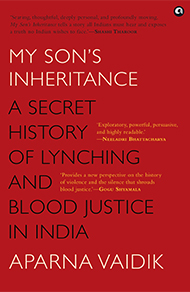What do you think?
Rate this book


192 pages, Hardcover
Published January 1, 2020
The Barbareek myth thus played a dual role: it maintained social cohesion and did so by normalizing or invisibilizing violence. The fact that he was not ‘really’ killed but continued to exist obviated Krishna’s guilt (of beheading him in one version and tricking him into cutting off his head in the other). The victim ultimately is not the victim because he does not get annihilated. As the Rig Veda says: ‘You do not really die through this, nor are you harmed. You go on paths pleasant to go on.’ For the Lord is divine and therefore sinless, he doesn’t suffer the sins of killing; and the act of killing becomes one of sacrifice. The myth thus redeemed Krishna’s actions from criminality. Barbareek’s sacrifice created a morally pure universe where the Lord is simply the nimitt, the source of liberation. The end goal of acquiring divine status normalized the violence of the beheading. Apotheosis wrote out the violence.These are the two tales the author chooses as pivots to hang her premise on. The mleccha Muslim as the hated other, and the "Hindu" Dalit as the willing victim. And this is entirely believable; that is how the Hindu ethos has been created and developed, ever since the late nineteenth century.
This was not a simple ‘politicization of religion’, a phrase that has come to dominate the way people understand the relationship between religion and politics. This phrase conveys a simplistic understanding where politics is seen as despoiling the purity of religion. It refers to an instrumentalist use of religion towards nefarious ends. Conceived in this way, it presents religion as existing in a pure realm untarnished by human agency and politics as being this-worldly and a product of baser human emotions and actions. However, this understanding ignores the fundamental political character of religion. Religion has always been political and politics has rarely ever not drawn on religion, its symbols or its vocabulary. They have always shared a symbiotic relationship.So far, this was an excellent book. But... it stops there. After having laid this framework about how Indian culture invisibly internalises violence, the author does not take it further. There are no actual studies linking this manufactured ethos to caste and communal violence, of which there are a plethora of examples in modern India. So I felt I had read just half a book.
So Babu, your parents’ story is one of miscegenation. Both Bharmall and Barbareek were your ancestors. Your father and I embodied them and now you do. This is your inheritance. Inheritance by definition is not always of your choosing. But while you are tethered to it, you are no way bound by it. You are free to choose the elements of your inheritance that you wish to own, to discard, to celebrate, to be indifferent to, or even to fight. Your inheritance will acquire the meaning you give it.
"The perpetrators of this violence have not always been the state, the rulers, the police or the army but also our silence. Our looking away from inconvenient truths, our blindness to our social capital, and in our ability to pass off our unearned privilege as merit or as advantages earned by hard work. It makes us either remain silent or glorify non-violence as our essence."